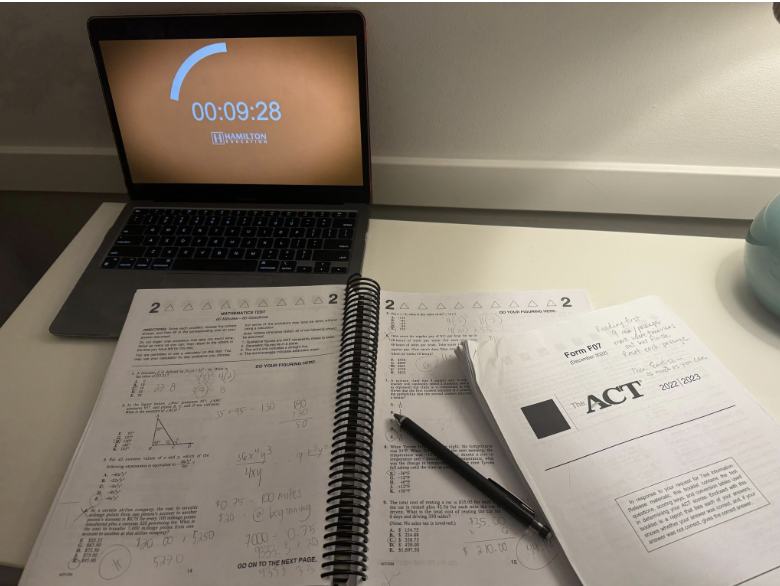Behind the scenes of BSM’s play productions
So many more students contribute to a theater production’s success than just the actors performing on stage. BSM students have the option to participate in a production as set builders, techies, or assistant stage managers without having to be talented actors.
Much more work goes into a play, on and off the stage, than the audience may realize.
November 5, 2014
Leads
You know who they are. They sing, dance, and act their hearts out on stage in full costume. With microphones taped to their cheeks, they get dolled up with mascara, and fill their hair with so much hairspray there’s a hole in the ozone layer above their heads. The flowers, the hugs, the love, and the constant praise are not at all undeserved.
“It’s a group effort. People need to understand that it is not just the leads, there are so many parts of theater. There are stage managers, directors, musicians if it’s a musical, techs, the actors themselves; there’s not only the leads in the play, and sometimes I think that people only see that,” sophomore Ty Hansen, who played the leading actor Ichabod Crane in Sleepy Hollow, said.
Actors put a lot of time into perfecting their art through rigorous practice. “Basically, it’s like the normal rehearsal time, which is about 20 hours a week roughly, and learning your lines at home. Like in the past for Dead Man Walking, I’d spend every night doing lines for about half an hour, but for [Sleepy Hollow], it’s shorter. I kind of just did a couple of weekends just practicing my lines at home and running them with different people,” senior Jacqui Theisen, who played leading actress Katrina Van Tassel in Sleepy Hollow, said.
Leads feel pressure to be a leader for the entire cast, be on time, not make mistakes, and not fool around. “Since I’m only a sophomore, the freshmen, they’ll be with me the longest time and they’ll be looking up to me. I guess have a lot of pressure from that. That’s my mentality, that I need to do good for the whole cast. It’s not just a one man show,” Hansen said.
Although being a part of the cast is demanding, it is an overall rewarding experience. “It’s nice to feel the support of the people around you also doing the same thing. You are all working together to make a story; it’s a really cool feeling to have on stage,” Theisen said.
ASM
If you aren’t a dedicated theater-goer, you probably have never heard the term ASM, which stands for assistant stage manager. ASM’s put in a significant amount of time––approximately fifty hours––in preparing for the production. “We’re behind the scenes, and we move set pieces to their desired locations, whether that be on stage or off,” ASM Obasi Lewis said.
Stage managers hold a favorable job when it comes to the possible roles in a production. They have a relatively simple, but imperative job. Each ASM is responsible for following along with the performance and moving set pieces and props. “It’s fun because you get to bond with the cast and also the techies, so it’s the best of both worlds,” Lewis said.
Currently, Lewis and junior Grace Kitzenburg are the resident ASM’s. A typical day as an ASM could include anything from personally handling and wrangling Toto, “spiking” where props are put on stage, or operating fog machines and chatting with cast backstage.
Tech
Techies are often referred to as “the nerds of the theater.” They are in charge of microphones, spotlights, sounds, and normal lighting. Without them, the audience wouldn’t see or hear a peep out of the actors and actresses. Even though they are often overlooked, the techies majorly contribute to the production. “I love seeing the final show and knowing that I contributed in a good way, and it’s meaningful, the work I do is meaningful,” junior Anna Von Kampen said.
Techies may not glorify the stage, but they still have a large time commitment. For last year’s musical, they put in an estimated 60+ hours, and for Sleepy Hollow, approximately 15 to 20 hours. “I love tech. It’s one of the only things I’m involved in so it takes a lot of time, but it’s fine because I think it’s so fun,” Von Kampen said.
Von Kampen describes her various responsibilities as a lighting techie. “We are responsible for the lights, so that means that we follow the instructions of the lighting designer and we make sure that everything is lit correctly. We also are in charge of spotlight, to make sure that the actors can be seen on stage in the dark,” Von Kampen said.
Set
Even with the best acting, perfect lighting, and flawless managing, a production would be nothing without a well-built set. Constructing a set is no small task, and it requires a horde of BSM’s most handy and dandy students to put in approximately ten hours a week for musicals, and about four for fall plays to successfully create an alternate world for the actors to live in.
“They need the set for the play to help set the scene, to create an atmosphere of drama, and to build the atmosphere. It adds depth to the play,” sophomore set builder Maya Berg said.
When set workers show up, they have to be prepared for whatever scenic director Scott Effertz throws their way, and that in itself deserves appreciation. A typical day could include building platforms, cutting wood, hanging up the backdrop, painting the floor green, wrapping vines around fluorescent tubes, or cleaning out the prop room.
Along with various jobs come the physical implications of constructing the entire set. However, the set is never truly finished. “People have broken things that we’ve built, like they’ll run into it and it’ll break off,” sophomore Molly Keady said.
Set construction can be a physically demanding and surprisingly dangerous task. These crucial aspects to the drama team must be prepared to lift heavy platforms, climb tall ladders, or wield a chainsaw. “I shot myself in the thumb with a staple gun,” Berg said






















































